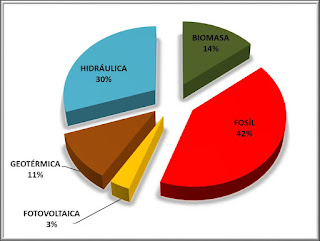Renewable energy in El Salvador
 |
| Source: 2017 SIGET statistics report |
- Fossil fuels (primarily fuel oil) - 42%
- Hydro - 30%
- Biomass - 14%
- Geothermal - 11%
- Solar -- 3%
To reduce dependence on fossil fuels, which contribute to greenhouse gasses and must be imported from volatile international markets, El Salvador would need to increase the use of renewable energy sources. El Salvador has numerous renewable energy sources as described in this August 2017 report from the US government:
El Salvador contains vast water reserves and receives large amounts of sunlight. Therefore biomass, wind, solar, hydroelectric and geothermal energy opportunities exist in the country. In order to facilitate the projects organizations such as: The Inter-American Development Bank, USAID and OPIC fund major energy projects with in the country.
Solar is the newest source to start contributing to the Salvadoran electrical grid, with the opening in El Salvador of the largest solar power plant in Central America last year.
El Salvador's first wind farm has been announced for construction in Metapán, in Santa Ana department in northwestern San Salvador. The wind farm is projected to come online in 2020 with 15-20 wind turbines.
A report this week from ThinkGeoEnergy.com stated that El Salvador could also triple its current geothermal capacity, given sufficient resources:
El Salvador could increase its installed geothermal power generation capacity from today 204 MW to 640 MW with its resources, according to a specialist at the Inter-American Development Bank. This though requires heavy investment and capacity building efforts.Current biomass energy in El Salvador comes from the use of bagasse as a fuel. Bagasse is a byproduct of the sugarcane processing industry, and so is primarily available during the cane harvest from November through April. In El Salvador, with its large sugarcane industry, bagasse electrical generation occurs at cane processing mills, where electricity is also sold back to the electrical power grid.
Through this mix of renewable resources, El Salvador has the prospect of reducing the proportion of its electricity generated by burning imported fuel oil. The challenge will be finding the dollars to invest in renewable resources and the technical skills to bring the projects online.
Comments